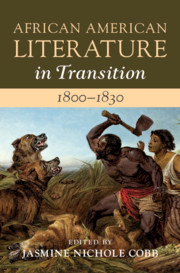Book contents
- African American Literature in Transition, 1800–1830
- African American Literature in Transition
- African American Literature in Transition, 1800–1830
- Copyright page
- Contents
- Figures
- Contributors
- Preface
- Chronology
- Introduction
- Part I Black Organizational Life before 1830
- Part II Movement and Mobility in African American Literature
- Part III Print Culture in Circulation
- Part IV Illustration and the Narrative Form
- Chapter 10 Theorizing Vision and Selfhood in Early Black Writing and Art
- Chapter 11 Embodying Activism, Bearing Witness
- Chapter 12 Visual Insubordination within Early African American Portraiture and Illustrated Books
- Index
Chapter 11 - Embodying Activism, Bearing Witness
The Portraits of Early African American Ministers in Philadelphia
from Part IV - Illustration and the Narrative Form
Published online by Cambridge University Press: 11 March 2021
- African American Literature in Transition, 1800–1830
- African American Literature in Transition
- African American Literature in Transition, 1800–1830
- Copyright page
- Contents
- Figures
- Contributors
- Preface
- Chronology
- Introduction
- Part I Black Organizational Life before 1830
- Part II Movement and Mobility in African American Literature
- Part III Print Culture in Circulation
- Part IV Illustration and the Narrative Form
- Chapter 10 Theorizing Vision and Selfhood in Early Black Writing and Art
- Chapter 11 Embodying Activism, Bearing Witness
- Chapter 12 Visual Insubordination within Early African American Portraiture and Illustrated Books
- Index
Summary
This chapter examines the strategies of producing and reproducing images of African Americans that subverted a culture of racist imagery created between 1810 and 1830. The portraits of four Black ministers – John Gloucester, Jeremiah Gloucester, Absalom Jones, and Richard Allen – provide opportunities to explore political, religious, and cultural debates facing African Americans during these decades. The acts of commissioning and circulating images underscore these leaders’ claims of citizenship and their right to Black religious independence. The chapter situates their portraits within the derisive and much more popular images of African Americans. Two groups of images studied in the chapter – the “bobalition" prints and Edward Williams Clay's "Life in Philadelphia" series – mock Black success, antislavery work, and patriotism. Analyzing the circulation, intended viewership, and medium of the images examined in this chapter enables a richer understanding of how African Americans recognized that, as cultural producers, they held stakes in the portrayals of blackness. Furthermore, their images expanded and refined discourses of race in the first few decades of the nineteenth century.
Keywords
- Type
- Chapter
- Information
- African American Literature in Transition, 1800–1830 , pp. 288 - 315Publisher: Cambridge University PressPrint publication year: 2021

